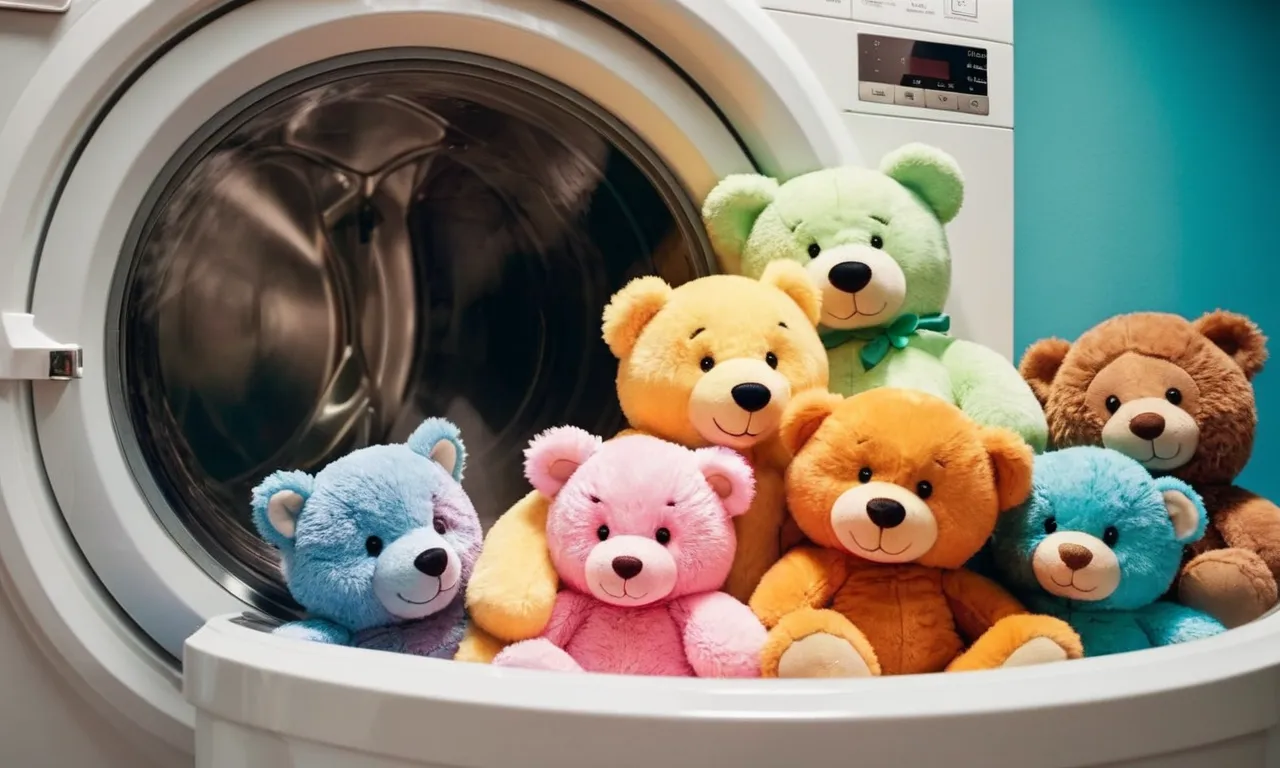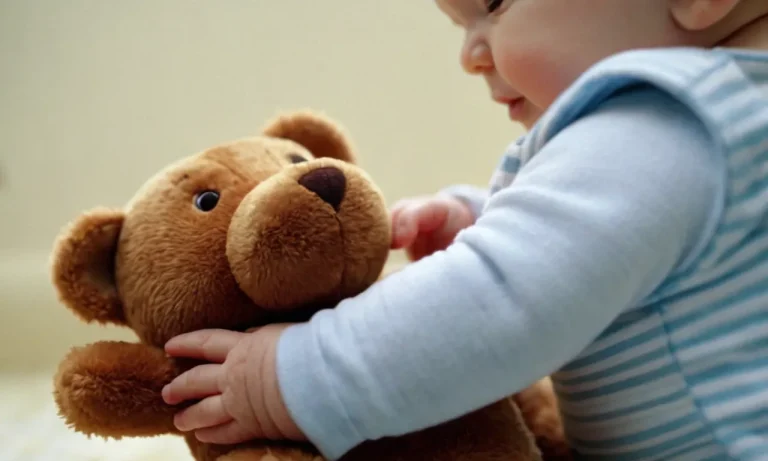Is your child’s favorite stuffed animal looking a little worse for wear? Have your collectible plush toys lost their luster over time? Washing big stuffed animals can seem daunting, but with the right techniques, you can have them looking fluffy and clean in no time.
If you’re short on time, here’s a quick answer to your question: Check the toy’s tag for washing instructions, use a mild detergent and gentle cycle, air dry the stuffed animal, and brush it when fully dry to restore fluffiness.
In this comprehensive guide, we will cover everything you need to know about machine washing oversized stuffed animals, from assessing fabric type and construction to choosing the best washing method, drying, and post-wash care for optimal results.
Assess the Stuffed Animal’s Size, Fabric, and Construction
Ensure it will physically fit in your washer
The first step is to make sure your large stuffed animal will actually fit inside your washing machine. Measure the dimensions of the stuffed toy as well as the tub of your washer before proceeding (don’t forget to account for any attachments like long limbs!).
If it is a tight squeeze, you may want to take it to a laundromat with larger capacity machines instead.
Identify fabric type
It’s important to know what type of fabric your stuffed animal is made of so you can select the proper washing method. Common materials like polyester, cotton, nylon, and poly-fiber blends are generally machine-washable. Check the manufacturer’s tag to identify the composition.
However, vintage or homemade stuffed animals that lack tags will require some sleuthing on your part to determine if machine washing is safe. When in doubt, opt for a gentle hand wash instead.
Inspect seams and attachments
Give your large stuffed friend a thorough once-over to ensure it can withstand machine washing. Flip it inside out and run your fingers over every inch, paying special attention to areas like:
- Seams – Are the stitches loose or frayed? These could easily come undone in the wash.
- Eyes and noses – Make sure they are tightly secured. Plastic parts may need to be removed first.
- Velcro and ribbons – Detach anything that could get caught or tangled during the cycle.
- Noisemakers – Remove batteries and electronic parts that could be water damaged.
Performing repairs beforehand can save you many frustrating post-wash mishaps. Some common remedies include re-stitching to reinforce weak seams, gluing plastic noses back on, or removing parts entirely if needed. Attaching accessory items like bows, bells, and squeakers afterward is also smart.
| Safe to Wash? | Better to Hand Wash |
| – Cotton | – Silks or velvets |
| – Polyester fabrics | – Antique collectibles |
| – Stuffed with poly-fiber fill | – Faux furs or sheared fabrics |
While most modern plush toys can safely take a spin in the washing machine, it’s best to hand wash fragile materials or collectibles to preserve them. When assessing vintage items in particular, remember – if in doubt, wash by hand with care!
Properly evaluating the size, fabric, and construction ahead of time takes some diligence but helps ensure your beloved stuffie makes it through the wash unscathed. So check those manufacturer’s tags, inspect every nook and cranny, and address any vulnerabilities you discover.
Your patience will pay off with years more hugs and snuggles from a fluffy-fresh friend!
Check the Toy’s Tag for Washing Instructions
The first step when washing any stuffed animal is to check the tag for care instructions. Most large stuffed animals will have a sewn-in tag somewhere with details on whether machine washing is allowed and if there are any special instructions.
Here are some things to look for on your stuffed animal’s tag:
- Material – Knowing the filling and outer fabric material can determine if machine washing is safe. Polyester and cotton blends are usually fine, but materials like silk or wool may require hand washing.
- Wash cycles – The tag may specify gentle/delicate cycles only.
- Water temperature – Warm or cold water is best for preserving fabrics and stuffing shape.
- Bleach instructions – Never use bleach unless explicitly allowed.
- Drying method – Air dry only or tumble dry low/no heat are common instructions.
If the stuffed animal’s tag is worn or missing, use some caution. Check seams to see if the toy is well-constructed and spot clean a small hidden area first to test colorfastness. When in doubt, opt for the gentlest cleaning method possible – handwashing and air drying flat.
Washing Machines Vary – Know Your Model
While most home washing machines can accommodate a large stuffed animal, it’s important to assess the internal capacity of your particular appliance before tossing your beloved friend inside.
Front-loading high-efficiency (HE) washers tend to have more internal space than traditional top-loaders. Measure your stuffed animal in multiple dimensions, then compare to your washer tub size. There should be 2-3 inches of clearance on all sides for the best motion and cleaning.
| Washer Type | Average Tub Volume |
| Top-loader | 3.5-5 cubic ft |
| Front-loader HE | 4-6 cubic ft |
If your stuffed friend won’t fit safely, look for nearby laundromats with larger-capacity washers or consider hand washing instead.
Protect Delicate Parts from Damage
Before machine washing, inspect your stuffed animal closely and take some protective steps:
- Tighten loose seam threads and re-stitch any holes/rips – this prevents further damage during washing.
- Place small accessories like hats and glasses in a delicates bag.
- If the toy has plastic eyes or noses, carefully remove them and set aside to reattach later.
- For long fur or yarn hair, gently twist and wrap strands with a hair tie or ribbon to prevent excessive tangling.
Be extra careful with antique or collectible stuffed animals – consider professional laundering services instead of DIY washing to prevent irreparable harm.
Choose the Right Washing Method
Wash stuffed animals separately
When it comes to keeping your beloved stuffed pals clean, the first rule is: always wash stuffed animals separately from your regular laundry. Tossing them in with towels or jeans can damage their fibers, cause the dye from clothes to bleed onto them, and leave unwanted lint behind.
Give your stuffed BFFs the special treatment they deserve!
Use a gentle cycle and cold water
Stuffed critters tend to be more delicate and sensitive than your average tee, so you’ll want to treat them gently in the wash. Choose a gentle or delicate cycle if your machine has one, and use cold water to prevent colors from running or materials from shrinking.
An occasional light spin is fine, but refrain from high-heat drying cycles that can scorch sensitive faux furs or matted materials.
Add a mild detergent
When prepping your wash, steer clear of harsh detergents, additives, or bleach that could degrade fabrics or strip colorful dyes. A mild liquid detergent is your best bet for keeping stuffed pals fresh and bright without damaging materials.
Bit of insider advice – skip the fabric softener, as it can leave an unwanted film or residue behind on plush exteriors.👍
Use a laundry bag for extra protection
If you’re worried about a special stuffed friend getting battered around during the wash cycle, add an extra level of protection by placing it inside a mesh laundry bag first. This prevents items from rubbing against the machine drum and guards against any loose decorative details coming unstitched.
Voila – stuffed animals emerge fluffy and fabulous! 🧺🧵
| Washing Method | Recommendation |
|---|---|
| Cycle Setting | Gentle or Delicate |
| Water Temperature | Cold |
| Detergent Type | Mild Liquid |
| Extras | Laundry Bag (optional) |
Follow these stuffed animal washing tips, and you can safely refresh your plush pals without causing any harm. Snuggles for all! 😊
Dry Thoroughly and Gently
Air dry is best
Allowing your stuffed animals to air dry naturally is the safest and gentlest drying method. Simply let them sit out for 24-48 hours, periodically flipping or adjusting them to expose all sides to air. This prevents heat damage and allows thorough drying inside and out.
Machine dry on low if needed
If time is short, a low heat tumble dry cycle can work. Choose no heat, low heat, or the “air fluff” no heat setting. Remove promptly at the end of the cycle as over-drying can damage the stuffing or lead to mold if any moisture remains inside.
To quicken drying, place 3-4 new tennis balls in the dryer during the cycle. The balls will bounce around briskly dislodging more water.
Dry thoroughly to prevent mold
Completely drying stuffed animals is crucial to prevent mold growth inside. Always check for damp spots by squeezing firmly all over when done washing and drying.
If uncertain it’s totally dry inside, sprinkle a bit of cornstarch into the fur and leave it sit overnight. The cornstarch will absorb any lingering moisture to finish the drying process.
Restore Fluffiness with Brushing and Fluffing
After washing your beloved stuffed animals, they may come out looking a bit flat and bedraggled. Luckily, restoring their fluffy glory is easy with a few simple steps. The most important techniques are thorough brushing and vigorous fluffing.
Used together, brushing and fluffing can work wonders to revive your stuffed pals’ plush coats.
Brush Gently Yet Persistently
Start by gently brushing the whole surface of the stuffed animal with a soft bristle brush or pet grooming brush. Brush against the natural nap of the fur or plush fabric. Be sure to get into all the nooks and crannies around the ears, legs, and tail.
You may need to brush quite persistently to lift the surface fibers and restore loft. Just be gentle so as not to pull or damage any materials. A little patience goes a long way! Focus on areas that still seem flattened more than others.
As you brush, you should start to see the fur or fabric lifting and fluffing up. Keep at it until the whole surface looks revived and you’ve achieved the stuffed animal’s usual poufy personality once again. 😊
Fluff Vigorously with Your Hands
After thorough brushing, it’s time to use your own two hands for some vigorous fluffing. Squeeze sections of the stuffed animal gently but firmly and rub the fabric or plush between your hands and fingers. Knead and massage the entire surface, continuing to work against the natural nap direction.
Pay special attention to the limbs, head, and other areas most affected by the weight and motion of the washing machine. You may be amazed at how much additional fluff and loft you can restore just through persistent and strategic fluffing! 🤗
Here are some extra fluffing tips:
- For stuffed animals with wire armatures inside, gently bend and shape the limbs or head back into the proper pose as you fluff.
- If possible, fluff the underside of limbs, tail, etc. that may have gotten flattened against the body in the wash.
- Check for any seams or joins in the fabric and massage these to restore fluffiness inside and out.
Keep working section by section until everything looks delightfully fluffy from head to paw! Now your sweet stuffed pal is ready for more fun and cuddles. 🧸👍
Conclusion
Washing oversized stuffed animals doesn’t have to be a scary endeavor. By following a few simple guidelines, checking tags, and taking some special precautions like air drying, you can safely clean even your most precious plush pals.
A little tender loving care goes a long way when it comes to keeping our favorite furry friends looking their very best.
Knowing the right techniques like brushing after washing means you can confidently toss those teddy bears in the wash without worrying about damage. So go ahead and show that special stuffed animal some clean new love!







